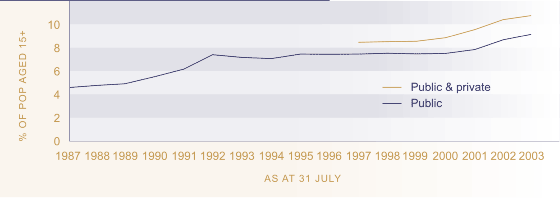Relevance
Participation in tertiary education provides individuals with skills and knowledge that allow them to participate in society and the economy.
Current Level and Trends
In July 2003, 11 percent of the population aged 15 and over (337,000 people) were enrolled in formal tertiary education, an increase from eight percent (246,600 people) in 1997. Long-term trend data is only available for public tertiary education institutions. In the mid-1980s, around five percent of the population aged 15 and over were enrolled in public tertiary education, compared to 9 percent in July 2003.
Figure K5.1 Tertiary education
participation rate, 1987-2003

Source: Ministry of Education;
Ministry of Social Development
Enrolments for courses that lead to qualifications below the level of a bachelor degree have risen faster than enrolments at degree level or above in recent years. In July 2003, six percent of the population aged 15 and over were enrolled in sub-degree tertiary education courses, an increase from three percent in 1994. In comparison, five percent of the population were enrolled in degree and post-graduate courses in 2003, a rise from three percent in 1994.
Tertiary education participation is highest among 18-24-year-olds. Recent increases in tertiary participation rates have been greatest at ages 25 and over, while participation under 18 years has declined.
Age and Sex Differences
Women are increasingly more likely than men to participate in tertiary study at ages 18 and over. The difference is greatest in the high incidence age group of 18-24 years, where the sex gap increased from four to seven percentage points between 1999 and 2003. There is little difference between males and females in the levels at which they are enrolled. Of all tertiary students enrolled in mid-2003, 38 percent of females and 37 percent of males were enrolled in degree courses and 8 percent of students of both sexes were enrolled in post-graduate courses.
Table K5.1 Tertiary participation rates (%) by age and sex, 1999-2003
| Sex, year | 15-17 years | 18-24 years | 25-39 years | 40+ years | Total |
|---|---|---|---|---|---|
| Males | |||||
| 1999 | 5.6 | 29.6 | 7.9 | 1.9 | 7.5 |
| 2000 | 7.9 | 31.2 | 8.4 | 2.1 | 8.0 |
| 2001 | 9.0 | 32.7 | 9.1 | 2.4 | 8.5 |
| 2002 | 8.0 | 33.3 | 9.9 | 2.8 | 9.0 |
| 2003 | 5.4 | 33.1 | 10.6 | 3.2 | 9.3 |
| Females | |||||
| 1999 | 5.5 | 33.9 | 10.2 | 3.4 | 9.2 |
| 2000 | 8.7 | 35.1 | 11.0 | 3.6 | 9.7 |
| 2001 | 8.5 | 37.3 | 12.4 | 4.0 | 10.6 |
| 2002 | 8.4 | 39.5 | 14.1 | 4.9 | 11.8 |
| 2003 | 4.5 | 39.8 | 15.1 | 5.5 | 12.2 |
Source: Ministry of Education; Ministry of Social Development
Ethnic Differences
Māori participation in tertiary education has increased sharply in recent years. In July 2003, the age-standardised tertiary education participation rate for Māori was 16 percent, almost double the rate in 1999 (eight percent). In comparison, non-Māori participation increased from eight percent in 1999 to ten percent in 2003. The age-standardised rate has been higher for Māori than non-Māori since 2000.40
Māori participation in tertiary education is higher than non-Māori participation among those under 18 and over 25, but considerably lower than non-Māori participation at the core tertiary education ages of 18-24 years. However, participation in this age group has been growing. In 2003, 26 percent of Māori aged 18-24 were enrolled in tertiary education, compared with 19 percent in 1999. The non-Māori participation rate at 18-24 years was 35 percent in 1999 and 39 percent in 2003.
Table K5.2 Tertiary participation rates (%) by age and sex, Māori, non-Māori, 2003
| Age group | Māori % | Non-Māori % | ||||
|---|---|---|---|---|---|---|
| Male | Female | Total | Male | Female | Total | |
| 15-17 | 8.6 | 8.5 | 8.6 | 4.5 | 3.5 | 4.0 |
| 18-24 | 19.2 | 32.5 | 25.9 | 35.9 | 41.4 | 38.6 |
| 25-39 | 13.2 | 26.6 | 20.2 | 10.1 | 12.9 | 11.5 |
| 40+ | 8.7 | 17.4 | 13.2 | 2.7 | 4.3 | 3.6 |
| Total | 12.2 | 22.4 | 17.5 | 8.9 | 10.7 | 9.8 |
Source: Ministry of Education; Ministry of Social Development
There are marked ethnic differences in the level at which tertiary students are enrolled, with Māori and Pacific students being less likely to be enrolled in degree level courses than students from European, Asian or Other ethnic groups.
International Comparison
There are currently no robust measures of tertiary participation across OECD countries. Some indication of New Zealand's relative standing can be gained from the proportion of the population enrolled in education at various ages. Taking the 20-29 year age group, who are more likely to be enrolled in tertiary than secondary education, in 2001, New Zealand ranked 14th with a rate of 23 percent; the same as the OECD median. The New Zealand rate was about the same as that of the United States and the United Kingdom, slightly above that of Canada (21 percent) but below the rate for Australia (28 percent).41
